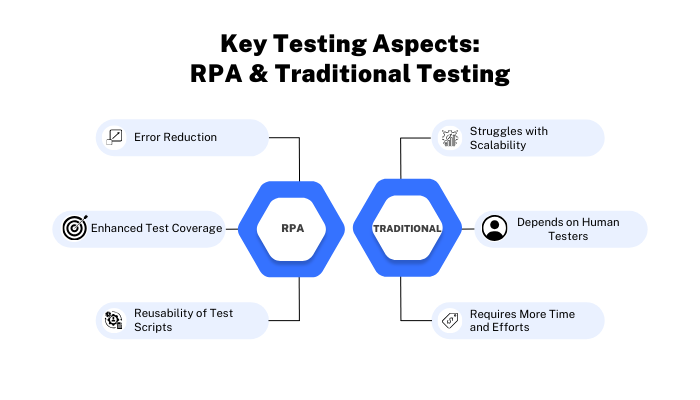What Is RPA Testing and Why It's Better Than Traditional Testing

There's an old catchphrase stating, “New is always better”. Well, the introduction of Robotic Process Automation (RPA) in the world of software testing services epitomizes this catchphrase.
If we talk about the traditional testing methods, they have been feeling the strain of this high-pressure testing world as repetitive tasks, human errors, and time constraints slow down the testing process. That is precisely where these modern test automation solutions, such as Robotic Process Automation (RPA) testing, are poised to revolutionize how we ensure software quality in the future, with its expected market value to reach $3.11 billion by the end of 2025.
But before we move onto the world of RPA testing, let's understand what we are dealing with. Traditional testing methods rely heavily on the manual actions of human testers as they verify every element and functionality of the software. While this standard approach has served us well for several years, it is inclined to human error and often needs help to stay in touch with the ever-increasing volume of required testing.
Picture a scenario where digital assistants manage all the tedious & repetitive tasks to free up the human testers, allowing them to tackle more strategic & innovative tasks. Well, that's the reality of RPA testing services. With the assistance of intelligent software bots, Robotic Process Automation (RPA) allows businesses to automate repetitive testing procedures that human actions & interactions with applications.
What is Robotic Process Automation (RPA) Testing?
Robotic Process Automation (RPA) involves using software bots to streamline the automation of recurring & rule-based tasks during a particular business process. According to several reports, RPA is expected to be adopted by almost all the businesses globally by the end of year 2030. This mandates the need for RPA testing to ensure these automation processes' accuracy, reliability, and efficiency. The key features of RPA testing include:
Firstly, RPA testing services significantly enhance the pace of testing processes. Bot testers can perform the testing cases much faster than their human counterparts, facilitating swift feedback on software quality.
Secondly, this testing method meticulously adheres to predefined rules, thereby increasing the precision and accuracy of the software testing by 90% compared to traditional testing methods. It also reduces the risk of human errors, which in turn ensures consistent test results.
Lastly, RPA testing decreases the overall cost of the testing procedure by effectively automating all the mundane & repetitive tasks. Despite the high initial investment required to set up infrastructure for RPA testing services, the long-term benefits are much more transformative in terms of time and resource savings.
What are Traditional Testing Services?
It relies on manual testing processes carried out by human testers. While manual testing has been the norm for many years, it comes with its own set of challenges and limitations. Let's explore some key aspects:
Traditional testing particularly struggles to keep up with the increasing demand for scalability, specifically in cases where the need for recurrent testing procedures is mandated. This is why RPA testing methods are on the rise because of its ability to tackle scalability concerns.
Traditional testing heavily depends on human testers to execute test cases, making it susceptible to human errors. Additionally, the need for human intervention can slow down the testing process.
Being a resource-intensive method, manual testing requires a significant amount of time and effort. As the complexity of software applications increases, testing them through a manual testing process becomes quite challenging and time-consuming.

How RPA Testing Varies from Traditional Testing?
From a technical standpoint, the superiority of RPA testing services becomes evident when considering certain statistics and technical aspects. According to research, RPA testing reduces the risk of errors and failures, leading to more robust software applications. The technical advantages include:
Error Reduction
RPA testing minimizes the risk of errors in testing by automating repetitive tasks. This leads to higher accuracy in test results and reduces the chances of critical errors slipping through. Which ultimately would result in an 86% Improved Productivity rate.
Enhanced Test Coverage
Automation in RPA testing allows for broader test coverage, ensuring that all aspects of an application are thoroughly tested. This is particularly beneficial in complex software environments where manual testing might overlook certain scenarios.
Reusability of Test Scripts
RPA testing allows for creating reusable test scripts, saving time and effort in test case design and execution. This reusability contributes to the efficiency and effectiveness of the testing process.
It's undeniable that RPA testing brings a paradigm shift in how we approach software testing. The integration of automation not only enhances efficiency but also empowers QA teams to focus on more complex and creative testing scenarios.
Choose What Aligns with Your Organizational Interests

Both methods possess unique strengths and weaknesses, making them ideal for different situations. Traditional testing remains the go-to for predictable test scenarios requiring high precision and scalability. Conversely, RPA thrives in environments with dynamic interfaces, complex workflows, and a need for rapid automation. The future, however, lies in a harmonious coexistence.
Imagine hybrid frameworks combining the precision of scripts with the adaptability of bots. Envision RPA bots triggering traditional automated tests for specific scenarios, enhancing overall test coverage and efficiency. This synergy, fueled by AI and machine learning, holds the key to unlocking a next-gen QA landscape.
The battle between Traditional & RPA testing is a transformative evolution, shaping a future where QA embraces versatility, adaptability, and human-robot collaboration. As the automation landscape continues to evolve, remember, the real winner is the one who embraces both sides of the coin, ensuring quality software that delights users and fuels business success.
To Wrap It Up
RPA testing services represent a powerful new weapon in the QA solutions arena. While not a complete replacement for traditional methods, it offers invaluable tools to tackle challenges and unlock greater efficiency.
By understanding the strengths and weaknesses of both approaches, we can confidently navigate the future of software quality assurance, ensuring a world where robots and humans work in harmony to build flawless software.